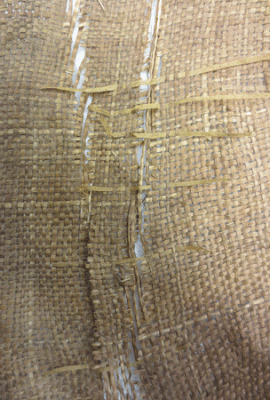 |
| 1945.11.130 Mat, Mo'orea |
This mat (Museum number 1945.11.130) from Mo'orea, an island 17km NW of Tahiti, was collected by Joseph Banks on Cook's first voyage (1768-1771), and subsequently given by Banks to Christ Church, his old Oxford college.
The mat is plaited from hibiscus bast fibres, and is unfinished. The strips of plant material are very brittle, and unsuitable storage over the years has resulted in several large tears in one corner of the mat.
 |
| Tears in one corner of the mat |
The conservation treatment on the mat began by surface cleaning using a dry, soft sponge to remove dirt residues. This was followed by humidification using an ultrasonic humidifier to restore some moisture and strength into the plant fibres.
The tears needed to be reinforced in some way, to prevent further damage which would result in sections of the mat being torn off completely. The material used was Japanese tissue, a type of hand-made long fibred mulberry paper. The paper was painted to blend in with the overall colour of the mat, using powder pigments in an acrylic matte medium, and narrow strips were cut which were the same width as the strips of hibiscus bast used to make the mat. A 'needle' was cut from thick polyester film, and a strip of tissue tacked to the end using superglue.
 |
| Weaving a strip of Japanese tissue across the tear |
The strip of tissue could then be woven across the tear, using tweezers to manipulate the needle, which was then cut off.
 |
| Several strips in place |
This was repeated many times, and the ends of the tissue strips were then adhered in place with a paste made from arrowroot starch, which is easily reversible in water should someone in future want to remove the paper strips. Once one end was securely fastened, the ends strips could be gently pulled to tension then across the tear, and the other end secured with a drop of starch paste.
 |
| Treatment nearing completion |
There are currently no plans to display this mat, but now it is more stable and less likely to be damaged by handling if required for study by a research visitor.